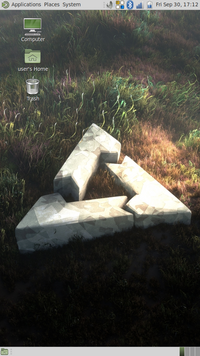MATE
 Default MATE configuration running on samsung-serranove | |
| In postmarketOS | |
|---|---|
| Package | postmarketos-ui-mate |
| Status | Available |
MATE is a desktop environment forked from the maintained code base of GNOME 2. It is installable on postmarketOS. However, it's less touch-friendly and configurable than Xfce4.
Installation
Run pmbootstrap init and choose mate in the interface section.
Additional software can be added at pmbootstrap init in step "Extra packages" or later on by sudo apk add ..., see also MATE#Additional_software.
Panel
- On small screens, the workspace switcher in the lower right corner is hard to click. A tweak to increase the size: Right-click the workspace switcher (for how-to see MATE#Input), click Preferences, double-click the first workspace name and change it to e.g. "- 1 -", change the second to "- 2 -" etc., finally check "Show workspace names in switcher". Pure spaces before/after the numbers are ignored, therefore a sign like the dash is needed. Between the number and the dashes, one or more spaces can be placed to "adjust" the size. Unfortunately, when showing the wokspace names, there is no miniature view of the windows placed on the workspaces.
- When yellow comment labels like e.g. "Click to view month calender" remain visible due to some combination of clicks, a right-click on the according item (in this example on the clock) helps to get rid of the label.
- The classic menu with categories "Applications, Places, System" can be replaced by a more compact menu (remove the classic menu by right-click, add the classic menu by right-click, move the icon by right-click). The more advanced "MATE menu" (screenshot) isn't packaged in Alpine Linux, unfortunately.
Display
Follow the Display guide to optionally change it to landscape mode or fix display related issues.
Input
- To simulate right mouse clicks with the touchscreen, long-click the return key of the onboard keyboard to get some mouse click options at the right side of the keyboard. For other possibilities of right mouse click emulation, see Input_methods#Simulate_secondary_click.
- Clicking the onboard icon in the panel shows or hides the virtual keyboard. In the settings of onboard, a bigger floating icon for show/hide can be enabled.
- If you can't grab something by touchscreen, use the keyboard (tab key to go through the elements, arrow keys to choose).
- Hiding the cursor is done by autostart command
unclutter-xfixes --start-hidden --hide-on-touch(just for information).
Lock screen
The screen lock kicks in when the screen saver gets active. For unlocking, onboard keyboard with layout "Phone" is called.
For devices with a hardware keyboard, this is unfavorable. The virtual keyboard can be disabled by command gesttings set org.mate.screensaver embedded-keyboard-enabled false.
For touch devices with bigger screen, the layout can be changed to e.g. "Compact" by gesettings set org.mate.screensaver embedded-keyboard-command 'onboard -e -l Compact'. For more options of the onboard command see e.g. debian manpage.
The onboard keyboard takes quite some time to show up when unlocking. Alternatively, matchbox-keyboard can be installed and then applied by gsettings set org.mate.screensaver embedded-keyboard-command 'matchbox-keyboard --xid'. However, it's not as configurable as the onboard keyboard.
LightDM
Autologin is configured by default. If you want to use LightDM as a login screen, see Display_manager#LightDM how to set this up.
Disk management
With the set of installed software, additional drives are not shown in the file manager. Install package udisks2 to make them available. (For more information see also pmaports#1377.)
As a graphical interface for formatting drives or image writing, e.g. package gnome-disk-utility can be installed (this installs udisks2 as well). After installation, it's at Accessories -> Disks.
Bluetooth
For bluetooth management package blueman is installed.
The tray icon needs right-clicking (for right-clicking see MATE#Input above). Alternatively use System -> Preferences -> Hardware -> Bluetooth Adapters and Bluetooth Manager, and sudo rfkill unblock bluetooth or block respectively to enable/disable.
The audio output can be changed at System -> Settings -> Other -> PulseAudio Volume Control -> Output Devices -> click the check button at the device you want to use.
For more information and troubleshooting see Xfce4#Bluetooth and Bluetooth.
Additional software
udisks2to make "removable" drives available.- As a browser, install e.g.
firefoxorfirefox-esr. To enable touch screen behaviour, add a new filesudo vi /etc/profile.d/firefox-touch-scrolling.shand writeexport MOZ_USE_XINPUT2=1, inabout:configchangedom.w3c.touch_events.enabledfrom 2 (default, auto-detect) to 1 (enabled). For better touch screen usability, install packagemobile-config-firefox(more information). - For phone applications, try
calls,chattyandgnome-contacts, which are used in Phosh. Packagemodemmanagerneeds to be installed (gets installed automatically with these packages), start the service bysudo rc-service modemmanager start, add it permanently bysudo rc-update add modemmanager defaultand reboot. - To view PDF files, install package
atril, for alternatives see PDF#PDF_viewers. - Graphical interface for formatting drives or writing images e.g.
gnome-disk-utility.
Gallery
-
MATE running on Samsung Galaxy S Advance (i9070)
